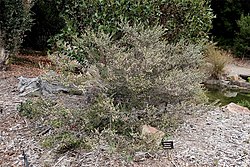Biology:Spyridium lawrencei
| Spyridium lawrencei | |
|---|---|

| |
| Flowers and leaves in the ANBG | |
| Scientific classification | |
| Kingdom: | Plantae |
| Clade: | Tracheophytes |
| Clade: | Angiosperms |
| Clade: | Eudicots |
| Clade: | Rosids |
| Order: | Rosales |
| Family: | Rhamnaceae |
| Genus: | Spyridium |
| Species: | S. lawrencei
|
| Binomial name | |
| Spyridium lawrencei (Hook.f.) Benth.[1]
| |

Spyridium lawrencei, commonly known as small-leaf spyridium or small-leaf dustymiller,[2] is a species of flowering plant in the family Rhamnaceae and is endemic to Tasmania. It is an erect, compact or straggling shrub with small, leathery, round to heart-shaped leaves, and dense heads of hairy, cream-coloured flowers.
Description
Spyridium lawrencei is a woody shrub that typically grows to a height of up to 1.0–1.5 m (3 ft 3 in–4 ft 11 in) and has many wiry branches. The leaves are thick, leathery, heart-shaped or more or less round and 2–4 mm (0.079–0.157 in) long with the edges curved downwards. The upper surface of the leaves is more or less glabrous and the lower surface is densely hairy. The heads or "flowers" are arranged on the ends of branchlets, surrounded by whitish, velvety floral leaves, the individual flowers cream-coloured, about 2 mm (0.079 in) wide with densely hairy bracts and sepals. Flowering occurs from late November to April, with a peak in February.[2][3][4]
Taxonomy
This species was first formally described in 1855 by Joseph Dalton Hooker who gave it the name Cryptandra lawrencei in The botany of the Antarctic voyage of H.M. Discovery ships Erebus and Terror from specimens collected by Ronald Campbell Gunn.[5][6] In 1863, George Bentham changed the name to Spyridium lawrencei in Flora Australiensis.[7] The specific epithet (lawrencei) honours Robert William Lawrence who discovered the species.[6]
Distribution and habitat
Spyridium lawrencei grows in the zone between riversides and woodland or forest on the central east coast and eastern midlands of Tasmania, mainly near to Swan, Apsley and St Paul Rivers.[2]
Conservation status
This species of spyridium is listed as "endangered" under the Australian Government Environment Protection and Biodiversity Conservation Act 1999 and the Tasmanian Government Threatened Species Protection Act 1995. The main threats to the species include changes in fire regimes, grazing and weed invasion, especially by gorse (Ulex europaeus).[2][4]
References
- ↑ "Spyridium lawrencei". Australian Plant Census. https://biodiversity.org.au/nsl/services/apc-format/display/54727.
- ↑ 2.0 2.1 2.2 2.3 "Approved Conservation Advice for Spyridium lawrencei (Small-leaf Spyridium)". Australian Government Department of Agriculture, Water and the Environment. http://www.environment.gov.au/biodiversity/threatened/species/pubs/27036-conservation-advice.pdf.
- ↑ Rodway, Leonard (1903). The Tasmanian Flora. Hobart: Tasmanian Government Printer. p. 28. https://www.biodiversitylibrary.org/page/37374780#page/72/mode/1up. Retrieved 2 August 2022.
- ↑ 4.0 4.1 "Spyridium lawrencei". Tasmanian Government Department of Primary Industries, Parks, Water and the Environment. https://www.naturalvaluesatlas.tas.gov.au/downloadattachment?id=14554.
- ↑ "Cryptandra lawrencei". Australian Plant Name Index. https://biodiversity.org.au/nsl/services/rest/instance/apni/507881.
- ↑ 6.0 6.1 Hooker, Joseph Dalton (1860). The botany of the Antarctic voyage of H.M. discovery ships Erebus and Terror in the Years 1839-1843 :under the command of Captain Sir James Clark Ross (Part III Flora Tasmaniae). London: Lovell Reeve. p. 72. https://www.biodiversitylibrary.org/item/90337#page/204/mode/1up. Retrieved 2 August 2022.
- ↑ "Spyridium lawrencei". Australian Plant Name Index. https://biodiversity.org.au/nsl/services/rest/instance/apni/456505.
Wikidata ☰ Q27828803 entry
 |


